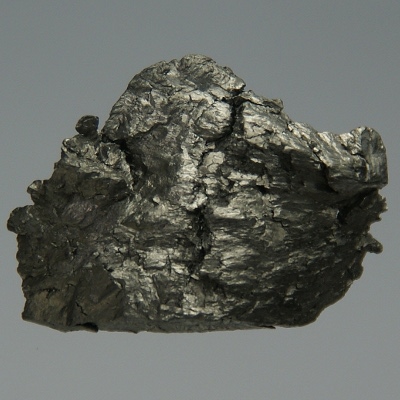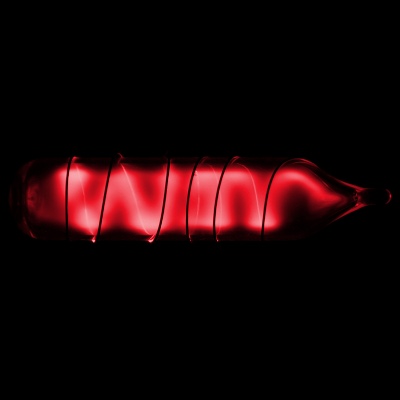Compare Gadolinium vs Radon: Periodic Table Element Comparison Table and Properties
Compare the elements Gadolinium and Radon on the basis of their properties, attributes and periodic table facts. Compare elements - Gadolinium and Radon comparison table side by side across over 90 properties. All the elements of similar categories show a lot of similarities and differences in their chemical, atomic, physical properties and uses. These similarities and dissimilarities should be known while we study periodic table elements. You can study the detailed comparison between Gadolinium vs Radon with most reliable information about their properties, attributes, facts, uses etc. You can compare Gd vs Rn on more than 90 properties like electronegativity, oxidation state, atomic shells, orbital structure, Electronaffinity, physical states, electrical conductivity and many more. This in-depth comparison helps students, educators, researchers, and science enthusiasts understand the differences and similarities between Gadolinium and Radon.
Gadolinium and Radon Comparison
Here's a detailed comparison between Gadolinium (Gd) and Radon (Rn), focusing on their position in the periodic table, physical and chemical properties, stability, and uses.
Facts - Basic Element Details
| Name | Gadolinium | Radon |
|---|---|---|
| Atomic Number | 64 | 86 |
| Atomic Symbol | Gd | Rn |
| Atomic Weight | 157.25 | 222 |
| Phase at STP | Solid | Gas |
| Color | Silver | Colorless |
| Metallic Classification | Lanthanide | Noble Gas |
| Group in Periodic Table | Lanthanide (no group number) | group 18 |
| Group Name | helium family or neon family | |
| Period in Periodic Table | period 6 | period 6 |
| Block in Periodic Table | f -block | p -block |
| Electronic Configuration | [Xe] 4f7 5d1 6s2 | [Xe] 4f14 5d10 6s2 6p6 |
| Electronic Shell Structure (Electrons per shell) | 2, 8, 18, 25, 9, 2 | 2, 8, 18, 32, 18, 8 |
| Melting Point | 1586 K | 202 K |
| Boiling Point | 3523 K | 211.3 K |
| CAS Number | CAS7440-54-2 | CAS10043-92-2 |
| Neighborhood Elements | Neighborhood Elements of Gadolinium | Neighborhood Elements of Radon |
History
| Parameter | Gadolinium | Radon |
|---|---|---|
| History | The element Gadolinium was discovered by J. C. G. de Marignac in year 1880 in Switzerland. Gadolinium derived its name from Johan Gadolin, chemist, physicist and mineralogist. | The element Radon was discovered by E. Rutherford and R. B. Owens in year 1899 in Germany. Radon derived its name From radium, as it was first detected as an emission from radium during radioactive decay. |
| Discovery | J. C. G. de Marignac (1880) | E. Rutherford and R. B. Owens (1899) |
| Isolated | P.E.L. de Boisbaudran (1886) | W. Ramsay and R. Whytlaw-Gray (1910) |
Presence: Abundance in Nature and Around Us
Parts per billion (ppb) by weight / by atoms (1ppb =10^-7 %)
| Property | Gadolinium | Radon |
|---|---|---|
| Abundance in Universe | 2 / 0.02 | - / - |
| Abundance in Sun | 2 / 0.01 | - / - |
| Abundance in Meteorites | 230 / 30 | - / - |
| Abundance in Earth's Crust | 5200 / 680 | - / - |
| Abundance in Oceans | 0.0007 / 0.000028 | 0.0000000000006 / 0.00000000000002 |
| Abundance in Humans | - / - | - / - |
Crystal Structure and Atomic Structure
| Property | Gadolinium | Radon |
|---|---|---|
| Atomic Volume | 19.903 cm3/mol | 50.5 cm3/mol |
| Atomic Radius | 233 pm | 120 pm |
| Covalent Radius | - | 145 pm |
| Van der Waals Radius | - | 220 pm |
Atomic Spectrum - Spectral Lines | ||
| Emission Spectrum |  |  |
| Absorption Spectrum |  |  |
| Lattice Constant | 363.6, 363.6, 578.26 pm | - |
| Lattice Angle | π/2, π/2, 2 π/3 | - |
| Space Group Name | P63/mmc | - |
| Space Group Number | 194 | - |
| Crystal Structure | Simple Hexagonal 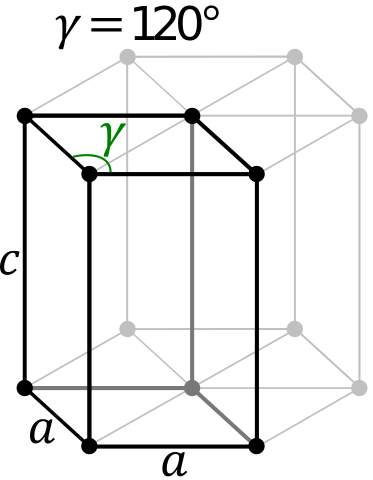 | Face Centered Cubic  |
Atomic and Orbital Properties
| Property | Gadolinium | Radon |
|---|---|---|
| Atomic Number | 64 | 86 |
| Number of Electrons (with no charge) | 64 | 86 |
| Number of Protons | 64 | 86 |
| Mass Number | 157.25 | 222 |
| Number of Neutrons | 93 | 136 |
| Shell structure (Electrons per energy level) | 2, 8, 18, 25, 9, 2 | 2, 8, 18, 32, 18, 8 |
| Electron Configuration | [Xe] 4f7 5d1 6s2 | [Xe] 4f14 5d10 6s2 6p6 |
| Valence Electrons | 4f7 5d1 6s2 | 6s2 6p6 |
| Oxidation State | 3 | 2 |
| Atomic Term Symbol (Quantum Numbers) | 9D2 | 1S0 |
| Shell structure | 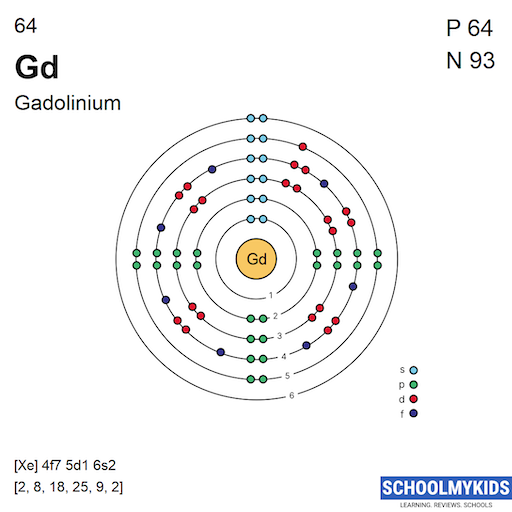 | 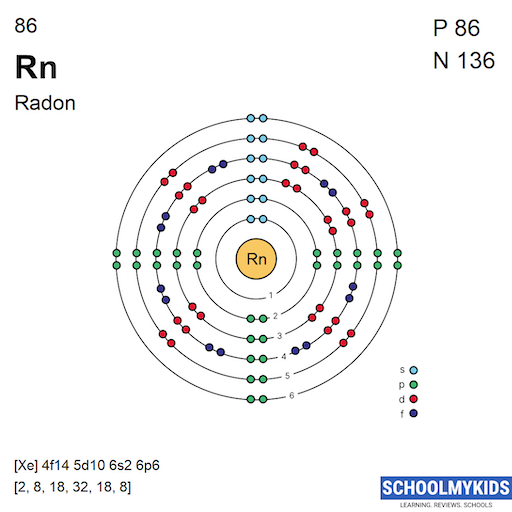 |
Isotopes and Nuclear Properties
Gadolinium has 6 stable naturally occuring isotopes while Radon has 0 stable naturally occuring isotopes.
| Parameter | Gadolinium | Radon |
|---|---|---|
| Known Isotopes | 134Gd, 135Gd, 136Gd, 137Gd, 138Gd, 139Gd, 140Gd, 141Gd, 142Gd, 143Gd, 144Gd, 145Gd, 146Gd, 147Gd, 148Gd, 149Gd, 150Gd, 151Gd, 152Gd, 153Gd, 154Gd, 155Gd, 156Gd, 157Gd, 158Gd, 159Gd, 160Gd, 161Gd, 162Gd, 163Gd, 164Gd, 165Gd, 166Gd, 167Gd, 168Gd, 169Gd | 195Rn, 196Rn, 197Rn, 198Rn, 199Rn, 200Rn, 201Rn, 202Rn, 203Rn, 204Rn, 205Rn, 206Rn, 207Rn, 208Rn, 209Rn, 210Rn, 211Rn, 212Rn, 213Rn, 214Rn, 215Rn, 216Rn, 217Rn, 218Rn, 219Rn, 220Rn, 221Rn, 222Rn, 223Rn, 224Rn, 225Rn, 226Rn, 227Rn, 228Rn |
| Stable Isotopes | Naturally occurring stable isotopes: 154Gd, 155Gd, 156Gd, 157Gd, 158Gd, 160Gd | |
| Neutron Cross Section | 49000 | 0.7 |
| Neutron Mass Absorption | 7.3 | - |
Chemical Properties: Ionization Energies and electron affinity
| Property | Gadolinium | Radon |
|---|---|---|
| Valence or Valency | 3 | 6 |
| Electronegativity | 1.2 Pauling Scale | 2.2 Pauling Scale |
| Oxidation State | 3 | 2 |
| Electron Affinity | 50 kJ/mol | 0 kJ/mol |
| Ionization Energies | 1st: 593.4 kJ/mol 2nd: 1170 kJ/mol 3rd: 1990 kJ/mol 4th: 4250 kJ/mol | 1st: 1037 kJ/mol |
Physical Properties
Radon (0.00973 g/cm³) is less dense than Gadolinium (7.901 g/cm³). This means that a given volume of Gadolinium will be heavier than the same volume of Radon. Gadolinium is about 81102.5 denser than Radon
| Property | Gadolinium | Radon |
|---|---|---|
| Phase at STP | Solid | Gas |
| Color | Silver | Colorless |
| Density | 7.901 g/cm3 | 0.00973 g/cm3 |
| Density (when liquid (at melting point)) | 7.4 g/cm3 | - |
| Molar Volume | 19.903 cm3/mol | 50.5 cm3/mol |
Mechanical and Hardness Properties
| Property | Gadolinium | Radon |
|---|---|---|
Elastic Properties | ||
| Young Modulus | 55 | - |
| Shear Modulus | 22 GPa | - |
| Bulk Modulus | 38 GPa | - |
| Poisson Ratio | 0.26 | - |
Hardness - Tests to Measure of Hardness of Element | ||
| Mohs Hardness | - | - |
| Vickers Hardness | 570 MPa | - |
| Brinell Hardness | - | - |
Thermal and Electrical Conductivity
| Property | Gadolinium | Radon |
|---|---|---|
Heat and Conduction Properties | ||
| Thermal Conductivity | 11 W/(m K) | 0.00361 W/(m K) |
| Thermal Expansion | 0.0000094 /K | - |
Electrical Properties | ||
| Electrical Conductivity | 770000 S/m | - |
| Resistivity | 0.0000013 m Ω | - |
| Superconducting Point | 1.083 | - |
Magnetic and Optical Properties
| Property | Gadolinium | Radon |
|---|---|---|
Magnetic Properties | ||
| Magnetic Type | Ferromagnetic | - |
| Curie Point | 292 K | - |
| Mass Magnetic Susceptibility | - | - |
| Molar Magnetic Susceptibility | - | - |
| Volume Magnetic Susceptibility | - | - |
Optical Properties | ||
| Refractive Index | - | - |
Acoustic Properties | ||
| Speed of Sound | 2680 m/s | - |
Thermal Properties - Enthalpies and thermodynamics
| Property | Gadolinium | Radon |
|---|---|---|
| Melting Point | 1586 K | 202 K |
| Boiling Point | 3523 K | 211.3 K |
| Critical Temperature | - | 377 K |
| Superconducting Point | 1.083 | - |
Enthalpies | ||
| Heat of Fusion | 10 kJ/mol | 3 kJ/mol |
| Heat of Vaporization | 305 kJ/mol | 17 kJ/mol |
| Heat of Combustion | - | - |
Regulatory and Health - Health and Safety Parameters and Guidelines
| Parameter | Gadolinium | Radon |
|---|---|---|
| CAS Number | CAS7440-54-2 | CAS10043-92-2 |
| RTECS Number | RTECSLW3850000 | RTECSVE3750000 |
| DOT Hazard Class | - | 7 |
| DOT Numbers | - | 2912 |
| EU Number | - | EU233-146-0 |
| NFPA Fire Rating | - | - |
| NFPA Health Rating | - | - |
| NFPA Reactivity Rating | - | - |
| NFPA Hazards | - | - |
| AutoIgnition Point | - | - |
| Flashpoint | - | - |
Compare Gadolinium and Radon With Other Elements
Compare Gadolinium and Radon with other elements of the periodic table. Explore howGadolinium and Radon stack up against other elements of the periodic table. Use our interactive comparison tool to analyze 90+ properties across different metals, non-metals, metalloids, and noble gases. Understanding these differences is crucial for applications in engineering, chemistry, electronics, biology, and material science.
